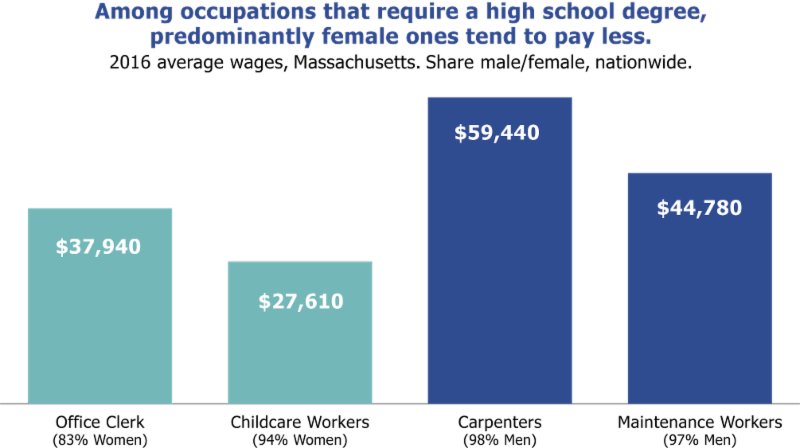#MeToo, the Gender Pay Gap, And Power Dynamics in the American Workplace
By Luc Schuster
January 29, 2018
This is an abbreviated version of our Boston Research Snapshot email newsletter from January, 2018. Sign up to get the newsletter in your inbox every month.
The #MeToo movement is confronting decades of workplace sexual misconduct that has been far too common for far too long. Punishing individual bad actors is a necessary first step, but it's likely insufficient for creating long-term change. Why? Because "(s)exual harassment does not occur in a vacuum." It's an effect of workplace power dynamics that undervalue women more generally. Another effect of these dynamics is the gender pay gap, which persists despite a broadly held belief that similar work deserves similar pay. Through recent work supported by the Boston Foundation (like salary negotiation trainings), we've come across some compelling research on how the gender pay gap functions and what we can do about it.
Estimates of the gender pay gap are in the 20 to 25 percent range. After controlling for factors like occupation and hours worked it closes to something like 7 percent. This remaining 7 percent can be thought of as a very rough estimate for the effects of direct discrimination.
Male-dominated jobs earn more than female-dominated ones, even when they are at similar skill levels.
The remaining 7 percent gap is certainly troubling, but focusing only on estimates of direct discrimination ignores other dynamics that may not be fair either. Controlling for occupation makes sense at first blush since you probably wouldn’t want to compare the wages of a highly-trained engineer with, say, the wages of a lower-skill retail worker. But, interestingly, pay varies widely across different occupations at similar skill levels, with traditionally male-oriented occupations being significantly higher paid. Take two occupations in Massachusetts that tend to require only a high school diploma: child care workers (94 percent of whom are women) make about $28,000/year, whereas carpenters (98 percent men) make $59,000/year. Matthew Yglesias at Vox.com describes this dynamic well in "Statistical controls tell us how the gender pay gap works, not that it isn’t real."
Also, WaPo's "Can we talk about the gender pay gap?" has great, detailed graphics showing the size of these dynamics across many more jobs.
The size of the pay gap within occupations also varies a lot.
The gender pay gaps within science and tech, for instance, are actually relatively small compared to the large gaps in business and law. What’s common about occupations with smaller pay gaps? They tend to include self-directed jobs with schedules that are less rigidly 9 to 5. Research scientists, for example, can often design schedules to meet their personal needs. A salesperson in business, by contrast, may be more constrained by a need to meet with clients during the traditional workday. Flexibilities around work time and total work hours end up mattering much more for women because they tend to shoulder more parenting responsibilities than men.
Similarly, the gender wage gap tends to be smaller for people right out of school (when they’re less likely to be raising families). And some occupations, like law, have large penalties for taking leaves from work during the middle of one’s career--this study of University of Michigan Law School graduates estimates an 8 percent pay penalty for taking one year off of work mid-career.
This explainer has great, accessible detail on some other dynamics causing the gender pay gap.
So, what can we do?
In Massachusetts, we already prohibit prospective employers from asking about salary history and require employers to provide earned paid sick time. We could also implement a statewide paid family leave program, so that all workers are given reasonable flexibility to care for newborn children or other family members. These are steps in the right direction, but to really make a difference we also need cultural changes at the workplace. Too many occupations demand working long days and and require traditional workweeks. Everyone, including men, could stand to benefit from reduced expectations to work crazy hours. Fortunately, new technologies like video chat and Slack can help support remote, flexible work, and more equitable workplaces.

